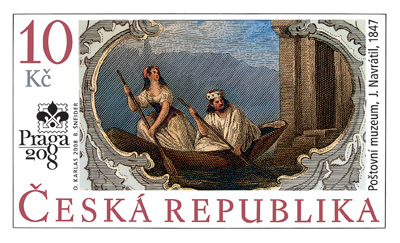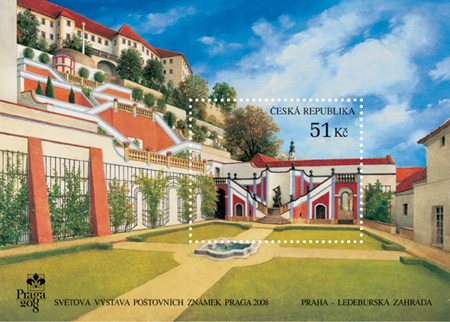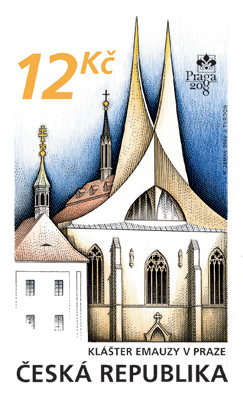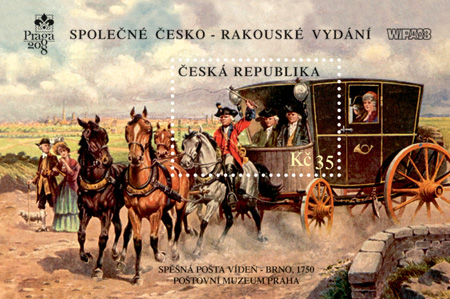![]() Fresh News:
Fresh News:
What other stamps will there be for the World Exhibition?
The year 2008, containing the numeral eight, is not only a traditional year for holding of the PRAGA exhibition, but also an anniversary of the independent Czechoslovak Republic, with which the founding of a number of new bureaus and institutions is connected.
For us, two anniversaries are of particular importance: the 90th anniversary of the issuing of the first Czechoslovak postage stamp and the 90th anniversary of the Postal Museum. These anniversaries overlap, so they are commemorated each year on 18 December by exhibitions and philatelic prints. The Postal Museum in Prague, having archives of all Czechoslovak and Czech stamps and all of the artistic and manufacturing documentation for stamp creation, is an indispensable institution documenting the entire 90-year history of the issuing of postage stamps. Its chief mission is the documenting of postal developments in this country,  presented by a newly updated exposition on the premises of the Cistercian Monastery in the town of Vyšší Brod, where there are unique exhibits. On 5 March 2008 a stamp with a face value of CZK 10 will be released for the 90th anniversary of the Postal Museum with a motif that the stamp’s designer, Otakar Karlas, drew directly from the theatrical salon in the museum. It is based on one of the murals by Josef Navrátil depicting the attractive subject of King Wenceslas IV with the Spa Servant Susanna taking him across the Vltava River in a boat. This cameo is one of 16 murals representing legends from Czech history (The Court of Libuše, the Calling of Přemysl to the Throne, Oldřich and Božena), theatrical scenes (Faust and Marguerite, William Tell) and even the artist himself – Josef Navrátil, who painted himself in front of an easel holding a palette and brush. His portrait is used on the FDC. The stamps were engraved by Bohumil Šneider. Besides blocks, the stamps will come out in a philatelic sheet with 8 stamps and 4 coupons.
presented by a newly updated exposition on the premises of the Cistercian Monastery in the town of Vyšší Brod, where there are unique exhibits. On 5 March 2008 a stamp with a face value of CZK 10 will be released for the 90th anniversary of the Postal Museum with a motif that the stamp’s designer, Otakar Karlas, drew directly from the theatrical salon in the museum. It is based on one of the murals by Josef Navrátil depicting the attractive subject of King Wenceslas IV with the Spa Servant Susanna taking him across the Vltava River in a boat. This cameo is one of 16 murals representing legends from Czech history (The Court of Libuše, the Calling of Přemysl to the Throne, Oldřich and Božena), theatrical scenes (Faust and Marguerite, William Tell) and even the artist himself – Josef Navrátil, who painted himself in front of an easel holding a palette and brush. His portrait is used on the FDC. The stamps were engraved by Bohumil Šneider. Besides blocks, the stamps will come out in a philatelic sheet with 8 stamps and 4 coupons.
J. Navrátil (1798-1865) was Prague’s most famous decorative painter, specializing in murals for bourgeois, noble and imperial residences. The lovely house at the address Nové mlýny 2, Prague District 1, the site of the Postal Museum, was the original residence for the mill that once stood there. In the 19th century, it belonged to Michalovic, a wealthy miller and patron of the arts, who entrusted his friend J. Navrátil with decorating the house. Besides the theatrical salon, he also decorated the former dining room, where there is a picture with a detail, Turin, Monte Superga, that is intimately familiar to philatelists.
 On 28 May 2008 a block of stamps designed by Adolf Absolon will come out. The stamps will depict Ledeburg Garden. Built in the early 18th century, it is one of the loveliest gardens on the southern slope below Prague Castle, and it constitutes a part of the continuous complex of palace gardens. Ledeburg Garden was later given its high Baroque appearance in 1787 by I. J. Palliardi, in the service of the Kolovrat family. The garden’s steep terrain is divided into five terraces, connected by staircases and balustrades. The octagonal gazebo at the summit crowns the entire monumental work. In the lower part of the garden near the palace is the Sala Terrena, decorated with stucco and paintings of mythological scenes by V. V. Reinera, dated 1730. The adjacent area with a fountain with Hercules wrestling, depicted on a stamp, leads to the terraces over a twin staircase. There is a fountain in the middle of the parterre. The Ledeburg garden was reopened in 1995 after renovations. It serves as an excellent venue for formal events including weddings. The stamp engraving is by Martin Srb. Monochromatic die stamp with combined offset printing is used for the block. The stamp’s face value is CZK 51.
On 28 May 2008 a block of stamps designed by Adolf Absolon will come out. The stamps will depict Ledeburg Garden. Built in the early 18th century, it is one of the loveliest gardens on the southern slope below Prague Castle, and it constitutes a part of the continuous complex of palace gardens. Ledeburg Garden was later given its high Baroque appearance in 1787 by I. J. Palliardi, in the service of the Kolovrat family. The garden’s steep terrain is divided into five terraces, connected by staircases and balustrades. The octagonal gazebo at the summit crowns the entire monumental work. In the lower part of the garden near the palace is the Sala Terrena, decorated with stucco and paintings of mythological scenes by V. V. Reinera, dated 1730. The adjacent area with a fountain with Hercules wrestling, depicted on a stamp, leads to the terraces over a twin staircase. There is a fountain in the middle of the parterre. The Ledeburg garden was reopened in 1995 after renovations. It serves as an excellent venue for formal events including weddings. The stamp engraving is by Martin Srb. Monochromatic die stamp with combined offset printing is used for the block. The stamp’s face value is CZK 51.
 Prague’s dominant features are more than just its ancient, historic towers, church steeples and palace roofs. Rightly counted among those features are such striking examples of contemporary or recent architecture as the Emmaus Monastery Church depicted on a CZK 12 stamp. The church, with its breathtaking, modern towers, was built in 1965-8 according to plans by the architect F. M. Černý. The original neo-Gothic twin towers above the church’s façade and the monastery were severely damaged by an American airstrike on 14 February 1945. Today, the shape of the amazing, asymmetrical, 32-meter concrete vaults with gilded spires evokes angel wings, creating an interesting dominant feature of the area of the New Town below the cliffs. The stamp, created by Karel Zeman in collaboration with the engraver Jaroslav Tvrdoň, will come out on 3 September 2008 in a 50-stamp block set in checkerboard format with pairs alternating in opposite directions (tête-bêche). The Dove and The Liberated Republic, from the years 1920-22, are other stamps from this country issued in that format.
Prague’s dominant features are more than just its ancient, historic towers, church steeples and palace roofs. Rightly counted among those features are such striking examples of contemporary or recent architecture as the Emmaus Monastery Church depicted on a CZK 12 stamp. The church, with its breathtaking, modern towers, was built in 1965-8 according to plans by the architect F. M. Černý. The original neo-Gothic twin towers above the church’s façade and the monastery were severely damaged by an American airstrike on 14 February 1945. Today, the shape of the amazing, asymmetrical, 32-meter concrete vaults with gilded spires evokes angel wings, creating an interesting dominant feature of the area of the New Town below the cliffs. The stamp, created by Karel Zeman in collaboration with the engraver Jaroslav Tvrdoň, will come out on 3 September 2008 in a 50-stamp block set in checkerboard format with pairs alternating in opposite directions (tête-bêche). The Dove and The Liberated Republic, from the years 1920-22, are other stamps from this country issued in that format.
In 1347 Emperor Charles IV founded the Na Slovanech monastery for southern Slavonic Benedictine monks in an effort to strengthen the Slavonic liturgy and to suppress the disputes between the Western and Eastern churches. This was the only Slavonic monastery in the empire ruled by Charles IV where the monks used Old Church Slavonic as the liturgical language. It got the name Emmaus from the chapter of the Gospel that was read on the day of its consecration (describing the meeting of Jesus with disciples in Emmaus). The monastery became a center of learning and art.
The triple-nave Monastery Church of the Virgin Mary, Saint Jerome and the Slavonic Patrons is one of Prague’s largest. Adjacent to it to the south is the four-winged monastery with arcades around the paradise garden. There is also a Gothic royal chapel, a capitular hall and a baroque refectory. The arcaded hallway is decorated with frescos that are among the most valuable remnants of the Gothic era. In 1990, the Benedictine order returned to the Emmaus Monastery, which is a national cultural landmark.
A joint Czech-Austrian issue commemorates two important philatelic events – the World Stamp Exhibition Praga 2008 and the immediately subsequent Wipa 2008 International Stamp Exhibition, to be held from 18 to 21 September 2008 in Vienna.
The subject of the joint issue is the express postal coach on the Vienna – Brno route in 1750. On the block, free use is made of a picture postcard published by the Union of Postal Officials in Vienna in the early 20th century and sent from Vienna to Prague on 23 December 1914. It now belongs to the collection of the Postal Museum in Prague. It bears a reproduction of a picture signed by K. Schnorpfeil, depicting a coach with a postillion and passengers drawn by a team of four horses. The landscape is even depicted in the background.
In 1750 regularly scheduled postal coaches (diligence) were running between Vienna and Brno. The first trial run on that route was made by the originator of the project, Baron Lillien, in 1749. If needed, a traveler could pay for a special, express trip in a postal coach according to his/her own requirements. The price of a trip was based on the distance, the number of horses, transfer stations etc., so it was very expensive and was used only in exceptional circumstances by travelers from the wealthiest classes. These coaches were usually drawn by teams of four horses, but teams of six or even eight could be used as needed. The uniform requirements for the postillion included a red doublet with blue facings, a post horn and high riding boots.
A block with a CZK 35 stamp with engraving designed by Václav Fajt has been printed by the Prague Post Securities Printer by die stamping in combination with offset printing. It will come out on 12 Sept. 2008, the day of the opening of the exhibition PRAGA 2008.
Manager of the Stamp Issuing Preparations Department
|
|
|
|
|
